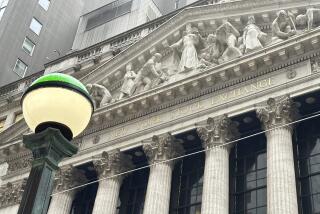Bond Funds Post Solid Gains
In the bond market, it was bulls gone wild in the third quarter.
But can they keep the party going?
As the economy slowed and the Federal Reserve halted its two-year-long credit-tightening campaign, some investors and traders rushed to buy bonds, pushing prices up and yields, or interest rates, down.
The result was the best “total return” quarter for government-bond mutual funds in four years and the best for corporate-bond funds in three years.
The average government-bond fund posted a total return -- interest earnings plus price appreciation -- of 3.2% in the three months ended Sept. 30, according to Morningstar Inc.
Falling interest rates drive up the share prices of bond funds because the fixed-rate securities they own become more valuable as rates on newly issued bonds slide.
A 3.2% quarterly gain may not sound like a lot, but it’s an annualized return of more than 13%, which is huge for fixed-income securities.
Most categories of bond funds gained between 2% and 3.5% in the quarter. Funds that own emerging-market bonds jumped 6.1%, on average, as interest rates fell worldwide.
Bond owners have to be happy. But on the flip side, the steep drop in yields since late June has brought widespread misery to some income-hungry investors who stayed on the sidelines, figuring it was too soon to lock in fixed rates.
They could have nabbed a 5.23% yield on a five-year Treasury note at the end of June. By the end of July the yield was 4.90%. Now, it’s at 4.64%.
Interest rates on tax-free California municipal bonds and funds, popular with Golden State investors, also have slumped. The yield on 10-year state general obligation bonds is at about 4%, down from 4.39% at midyear.
Having missed the early-summer peak in yields, many investors understandably are reluctant to buy bonds or bond funds now at much lower yields.
You’ll feel worse in a few months if you don’t, some market pros say. They believe yields will continue to fall amid a weaker economy, ebbing inflation concerns and expectations that the Fed will begin to cut short-term interest rates in 2007.
With energy prices down sharply since midsummer, “we’re going to get substantially better inflation readings” in the months ahead, said Lacy Hunt, co-manager of the Wasatch-Hoisington U.S. Treasury bond fund in Austin, Texas.
And because inflation is the primary threat to bonds (because it erodes their fixed returns), long-term yields will have room to decline further as investors stop worrying that inflation will rise, he asserts.
Hunt is extremely bullish on bonds. His fund owns many Treasury issues that don’t mature for 20 years or longer. He is betting that yields on new bonds will continue to tumble, and says they could fall back to their lows of 2003. The 10-year T-note fell as low as 3.12% in that year, compared with the current 4.70%.
The quandary for investors is that short-term yields, such as on money market funds, now are equal to or higher than yields on long-term Treasuries and are at least competitive with yields on many other categories of bond funds.
The average seven-day yield on money funds is 4.72%, according to IMoneyNet.com.
The only reason to give that up for a lower yield on a longer-term bond is if you figure that short-term rates will begin to drop, and sooner than later.
George Goncalves doesn’t think that will happen. The fixed-income strategist at Banc of America Securities in New York figures that, at best, the Fed will hold its key short-term rate at 5.25% for the foreseeable future.
In commentary from several Fed officials in recent days, “nowhere do they hint they’ll be easing rates” anytime soon, Goncalves said.
Although the economy has weakened, it will get support from the slide in energy prices and from the plunge in long-term interest rates, he said. That, in turn, will make it less likely the Fed will cut short-term rates, he said.
So Goncalves believes that investors will be better off waiting to buy bonds. He predicts that long-term yields will rebound in the next few months, to about 5% on 10-year T-notes, if he’s right about the economy and the Fed.
That rebound may have begun Friday, when yields jumped in the wake of September employment data that some bond traders viewed as pointing to underlying economic strength.
Investors in the corporate junk bond market -- high-yield securities issued by companies judged below investment grade -- also seem relatively upbeat about the economy. The average yield on an index of 100 junk bonds tracked by KDP Investment Advisors has fallen to 7.71%, down from a three-year high of 8.27% on June 26.
If junk investors feared that the economy was careening toward recession, they most likely would be demanding higher yields to compensate for the risk that more junk-issuing companies would go belly up.
That average junk bond fund generated a total return of 3.2% in the third quarter and was up 5.8% in the first nine months, beating the 5.2% average return of domestic stock funds, according to Morningstar. Junk funds are among the most popular categories of bond funds with individual investors.
With a still-expanding economy and rising corporate earnings, “we believe that the fundamentals are still pretty decent for the high-yield market,” said Eric Takaha, co-manager of the Franklin High Income fund in San Mateo, Calif.
Even so, he said, “we’ve moved a little more to the defensive in the last year.” That has meant shying away from the highest-risk, highest-yielding bonds in favor of better-quality issues, Takaha said.
One note of caution in the junk market is that company default rates are at record lows. That suggests there’s only one way for them to go: up. The only question is when.
*
(BEGIN TEXT OF INFOBOX)
Bond fund performance by Morningstar category
--Here are average total returns for bond mutual fund categories trackedby Morningstar. Total return is dividend or interest income plus orminus any principal change. All data are through Sept. 30. Figures forperiods longer than one year are annualized averages. For categorydescriptions and the best-performing funds in each category, seetables on Pages C7-8.
*--* Objective Total return Annuali zed total return 12-mo. Category category 3rd-q. YTD 3-yr. 5-yr. yield Long-term GL 6.8% 0.0% 4.3% 5.9% 3.8% government Emerging markets EB 6.1 5.8 11.9 16.3 5.5 Long-term CL 5.0 2.5 4.4 6.6 4.9 investment grade Intermediate-term CI 3.5 2.8 3.1 4.4 4.2 investment grade Multi-sector MU 3.4 4.0 6.4 8.5 5.4 Muni long-term ML 3.3 3.5 4.0 4.5 3.8 (national)* Muni California MC 3.3 3.4 4.4 4.5 3.8 long-term Intermediate-term GI 3.3 2.4 2.4 3.5 4.1 government High-yield muni HM 3.3 5.3 6.9 6.1 4.4 Inflation-protecte IP 3.3 1.4 3.8 6.0 4.6 d bond High-yield (junk) HY 3.2 5.8 8.0 9.1 6.9 Muni single-state SL 3.2 3.4 3.8 4.4 3.7 long-term* Muni MI 3.0 2.9 2.9 3.9 3.5 intermediate-term (national)* Muni California MF 2.8 3.0 2.7 3.5 3.3 intermediate-/shor t-term* Short-term GS 2.3 2.7 1.8 2.7 3.8 government Short-term CS 2.0 2.9 2.1 3.0 3.8 investment grade World IB 1.6 3.3 4.2 7.0 3.8 Bank loan BL 1.6 4.4 5.6 5.2 5.9 Muni short-term MS 1.5 2.3 1.6 2.5 2.8 (national)* Ultra-short-term UB 1.5 3.4 2.4 2.4 4.1 Government bond 3.2 2.2 2.5 3.5 4.1 fund avg. Corporate bond 3.1 3.6 4.3 5.6 4.9 fund avg. International bond 2.8 3.9 6.2 9.4 4.2 fund avg.
*--*
*Because interest on municipal bonds is tax--exempt, real returns willbe higher than stated returns and will depend on an investor’s taxbracket.
-Source: Morningstar Inc.
More to Read
Inside the business of entertainment
The Wide Shot brings you news, analysis and insights on everything from streaming wars to production — and what it all means for the future.
You may occasionally receive promotional content from the Los Angeles Times.









